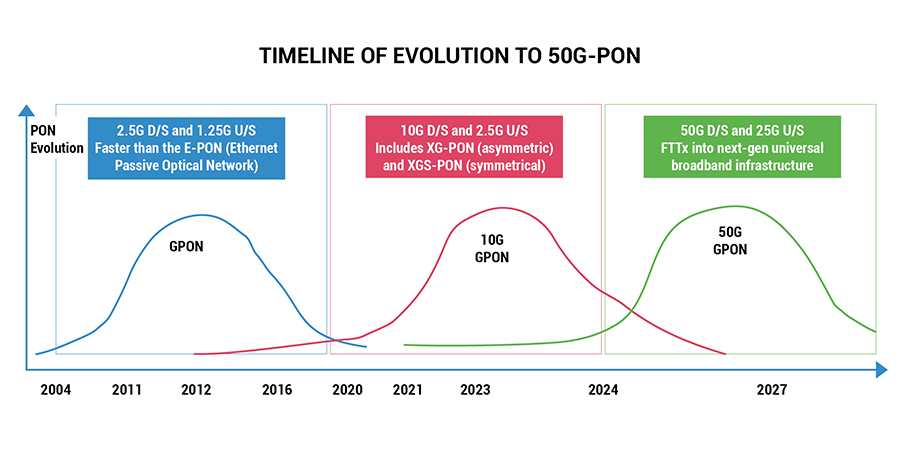Over the last two decades, passive optical network (PON) technology has evolved exponentially to support the fast-growing demand from emerging services like ultra-HD video, immersive experiences, 5G wireless transport and cloud, among others.
According to Cisco, the average broadband speed per user has grown and will continue to do so, from 45.9 Mbps in 2018 to 110.4 Mbps in 2023.
After the initial 1 Gbps speeds, PON standards have transitioned into 10 Gbit/s Ethernet PON and 10-Gigabit-capable PON (XGS-PON). The access speed of PON over a single wavelength has increased almost 100 times, and each generational upgrade in PON technology — expected every 8 to 10 years — is driven by the constant increase in bandwidth demand.
As more high-throughput, low-latency and high-availability services emerge, PON technology becomes a core element in building the gigabit society that is being deployed in most countries, including the Middle East region.
According to the ITU, worldwide bandwidth consumption grew at a CAGR of 50% from 2015 to 2021, with no regions showing any signs of slowing down. Even the African continent is advancing its journey of fiber optic deployments.
Timeline of Evolution to 50G-PON

Evolving from the Ethernet Passive Optical Network (E-PON), the massive deployment of Gigabit Passive Optical Network (GPON) from 2010–2020 was followed by 10G-PON from 2020 until the present.
Because users want greater broadband access speed, network operators have been upgrading to 10 Gigabit-capable Passive Optical Networks (XGS-PON) to provide faster Gigabit broadband service. By the end of 2021, nearly 10 million 10G-PON OLT ports had been deployed worldwide. Whereas in 2022, XGS-PON OLT port shipments had increased by 2231%, jumping from over 30,000 in 2019 to almost 750,000 by 2022.
10G-PON’s industry chain has already matured. In terms of standards, the ITU’s 10G GPON asymmetric 10G/2.5G started commercialization in 2012, while the symmetric 10G GPON 10G/10G 2016 standard began commercialization in 2017.
Because of this standardization, millions of homes and businesses can access global networks seamlessly. What is more, the next generation PON, known as Higher Speed PON (HSP), is set to provide speeds of 50 Gbit/s per wavelength.
50G-PON is the preferred next-generation choice after XGS-PON, as its time-division multiplexing-passive optical network (TDM-PON) can coexist with the previous PON technologies, increasing capacity by a factor of five versus 10G-PON and supporting new business requirements further.
In September 2021, the ITU-T officially published the first version of the 50G-PON standard. This includes technical specifications that support asymmetric rates and two generations of coexistence (10G-PON or GPON). A year later, the ITU-T added the technical specifications of the symmetric 50G-PON (50Gb/s in downstream and upstream) and the coexistence support for three generations (50G-PON, 10G-PON and GPON).
The 50G TDM-PON and 10G-PON coexistence evolution upgrade support smooth upgrading, with the implementation methods divided into two schemes: MPM dual-mode (built-in wave combining component) and external wave combining.
50G-PON: Benefits and Use Cases
The 50G-PON system capitalizes on the enhancements of optical transceiver components and introduces key innovations in activation procedures, contention-based operation and expanded cryptographic features — meeting the new and demanding requirements of the digital era.
The HSP project expands the capabilities of ITU-T PON beyond those of previous generations by increasing the line rate as well as enhancing its robustness and efficiency, while crucially supporting coexistence with installed deployments.
The 50G-PON systems support a continued and accelerated growth in user data traffic, which, combined with 5G wireless transport, increases and enables new applications such as smart power grids, industrial manufacturing and autonomous vehicles.
The PON technology is developing in various directions, one of which is all-optical access, where fiber-to-the-home (FTTH) is being upgraded to provide gigabit bandwidth in all corners. In FTTH construction, 80% of the total investment goes to the optical distribution network (ODN). The introduction of new technologies such as 50G-PON helps maximize this investment. To address this, Huawei’s 50G-PON solution features major innovations.
During MWC 2023, Huawei released the industry’s first commercial 50G-PON solution for ultra-broadband access, with optical modules increasing the following: transmit power by 4.5 times, photon absorption rate to nearly 100% and optical power budget by 25%.
Huawei’s 50G-PON optical modules also enable existing ODNs to carry new services by using innovative cell-level tapered amplifiers and superlattice reflection structures.
Ensuring a smooth service upgrade, Huawei’s 50G-PON optical modules are reduced by 40%, thanks to the unique high-precision angular multiplexing/demultiplexing and multi-component integrated chip technologies and one port that supports all three PON working modes — GPON, 10G-PON and 50G-PON.
Another direction is an all-optical campus where passive optical LAN (POL) technology replaces traditional Ethernet switches to implement fiber-to-conference room, fiber-to-camera, fiber-to-office desk and fiber-to-machine connections.
Huawei has gone all-in on 50G-PON, having demonstrated an early prototype at MWC 2019 based on mature 25G optical components that delivered 50-Gbps transmission over a single wavelength via physical PON links designed with fiber dispersion and transmitter/receiver bandwidth compensation technologies.
During MWC 2023 as well, Huawei launched the industry’s first 50G-POL prototype. This can help build next-generation Wi-Fi 7 campus networks. Cloud computing, big data and IoT technologies are being adopted on a larger scale in campus scenarios such as enterprise offices, education and healthcare. As a result, the requirements placed on the campus in terms of network bandwidth, latency and reliability are higher than ever before.
50G-PON is indeed the next-generation PON standard that improves low latency, slicing, energy savings and reliability, paving the way for a smooth evolution of 10G-PON.
Once fully commercialized, 50G-PON will be supported by a robust component and system supplier ecosystem, allowing the optical networks being built today to accelerate the convergence of residential broadband and smart city applications. This can be delivered with SLA-based enterprise and 5G mobile base station connectivity. This will also serve as the foundation for dozens of emerging applications and industry 4.0 use cases.
Without a doubt, 50G-PON will be a valuable tool in operators’ toolkits for business services and is well-suited to serve smart campuses, medical clinics, video production studios, smart factories, edge data centers and cloud-centric SMEs and SoHos.
A 50G-PON system can accommodate four 10 Gbps carrier Ethernet services, or one 25 Gbps service plus one 10 Gbps service, and complements other enterprise-heavy technologies, such as SD-WAN, massive machine vision and virtualized CPE.
50G-PON is also ideal for backhauling applications for emerging and future Wi-Fi scenarios like public hotspots and private wireless LANs. Small cell backhaul is a growing use case for 50G-PON, which can be seen for in-building small cells, such as in factories, shopping malls and airports.
Another vendor that is actively investing in and continuously advancing the industrialization of 50G-PON is ZTE. During MWC 2023, the company unveiled a three-mode Combo-PON product solution that supports the three generations of PON technologies with the same ODN through an independent wavelength stacking mechanism. This solves problems such as high construction costs, large space occupation in central offices, complex optical fiber cabling and difficult O&M during the PON evolution journey.
Sooner than later, we will see more commercialization of 50G-PON, driving fiber access applications to broaden coverage and capacity.










